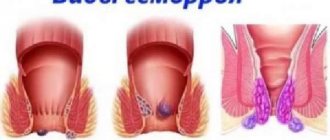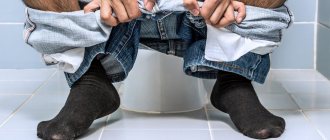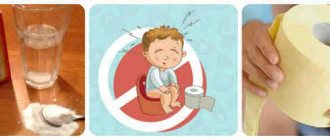Problems with the digestive organs, despite technological progress and the general high level of education of society, still haunt humanity today. About 40% of metropolitan residents of all ages suffer from chronic constipation. Few people know that the development of this “inconvenient” disease is facilitated by improper bowel movements. Today we will talk about how to sit on the toilet correctly so that the process of bowel movement meets physiological requirements and does not cause health problems on this page of the women's website “Beautiful and Successful”.
How to sit on the toilet correctly?
Before talking about the position for defecation, you should decide: how should bowel movements generally proceed? Physiologists say that the normal process of defecation always proceeds easily, without much strain on the intestinal muscles. Any tension that a person experiences when visiting the toilet is unnatural and entails a number of complications.
The design of modern “comfort” toilets forces people to sit at a 90-degree angle. In this position, the puborectalis muscle, which is responsible for removing feces from the body, compresses the intestines and makes it difficult for its contents to exit.
How to overcome constipation using various means >>
The angle of inclination between the hips and pelvis during bowel movements should be 35 degrees. This position is ensured by a squatting position. It will be useful for every adult and child suffering from constipation to master it.
Rinse off with the lid open
Did you know about such a phenomenon as “ toilet plume”
"? It consists of a mixture of small waste particles and toilet water that can spray 4.5 meters into the air when you flush.
A study conducted at the University of Oklahoma found that toilet plume plays a role in the transmission of infectious diseases.
In another study from the University of Leeds
found that the bacterium
Clostridium difficile
can rise 25 cm above the toilet seat every time you flush with the lid open.
This bacteria causes infection and leads to diarrhea and nausea. Therefore, always flush the toilet with the lid closed.
Why you shouldn't sit on the toilet for a long time
At a right angle, the intestines can also be released, but the process of defecation requires more time. The comfortable toilet that modern toilets are equipped with allows the visitor to comfortably sit on it and sit for 20-30 minutes, and sometimes much longer. Gadgets contribute to going to the toilet for too long: many people, wanting to combine business with pleasure, happily scroll through social network feeds while sitting on the toilet. When people stay too long, they sometimes don’t do what they came to the toilet for.
At the same time, during the entire time spent on the toilet, the intestinal muscles periodically tense and relax. This leads to the development of hemorrhoids or even a hernia. This is why you should not sit on the toilet for a long time: prolonged compression of the rectum leads to stagnation.
The site sympaty.net reminds its readers that stagnant processes can lead to a number of serious consequences, the most harmless of which will be weakness of the intestines and chronic constipation.
How much time can you spend on the toilet? According to doctors, the whole process should take no more than 2-3 minutes.
Constipation is caused by holding back bowel movements
Our internal locking mechanism is a stubborn companion! His main postulate: “What should come out will be brought out . The external locking mechanism is in continuous contact with the outside world and constantly evaluates: “Will it be convenient to use someone else’s toilet, or is it better not to? If I don’t go to the toilet now, I won’t be able to do it until later in the evening, which means I’ll have to be inconvenienced throughout the day!”
If we hold ourselves back from going to the toilet, suppressing urge after urge, then we inhibit the functioning of the internal locking mechanism and, as a result, can even damage it. The internal sphincter is in constant submission to the external locking mechanism. And the more the external sphincter commands the internal one, the higher the risk of developing problems and constipation.
Conscious suppression of natural processes occurring in the body should not be frequent , do not allow it to become a habit.
The gut is our second brain, responsible for intuition. It is not for nothing that the Russian language has preserved the expression: “I feel it in my guts” or “I feel it in my gut.” Therefore, it must be treated with care, and the natural process of defecation should not be suppressed.
How to sit if you have problems with bowel movements
Unfortunately, people think about how to sit on the toilet to free themselves from the contents of the rectum only when problems arise. In this case, doctors recommend changing your position. You can place your feet on the rim of the hygiene device, but in this position you can fall and get seriously injured.
To prevent going to the toilet from becoming a traumatic activity, it is recommended to use a special footrest.
Such stands are already sold in many stores and are quite inexpensive. If you place your feet on this stand when visiting the toilet, your knees will rise, producing the desired angle. The stand with height adjustment function is convenient for both men and women.
A footrest will help you take the correct posture
To bring the angle to 35 degrees, you can not adjust the height of the chair, but simply tilt the body forward.
Dry yourself thoroughly with toilet paper
© hermaion/Pexels
Aggressive scrubbing and over-cleansing with soap and scented wipes can irritate the skin between the buttocks, causing itching and inflammation.
Of course, you want everything to be clean after a bowel movement, but there is no need to scrub, use scented or colored toilet paper for this purpose.
Simply dry the area gently with regular toilet paper or a wet wipe, and in the shower, wash with mild soap and water.
How to sit on the toilet if your legs are numb or numb
Many people complain that their legs feel numb and numb when going to the toilet. This occurs because the sciatic nerve is pinched. At the same time, although sitting on the toilet for a long time is harmful, it is impossible to leave the toilet before completing the act of defecation. What can you do to make your intestines empty faster and your legs stop going numb? Doctors recommend taking a number of measures:
- Don't take your phone with you. The gadget distracts from the main purpose of visiting the toilet and forces you to take an uncomfortable position for defecation. The rule also applies to any entertainment: books, crosswords, magazines, etc.
- Choose a soft lid for the toilet that will squeeze the vessels with less force.
- When visiting the toilet, tilt the body forward to make the angle of inclination correct.
- Use a footrest.
It is better to stop reading and using gadgets
It is not difficult to follow these rules. However, women who have recently had an episiotomy (a cut at the back of the vagina during childbirth) may not be comfortable with these requirements.
Using bleach to clean the toilet
Using bleach in itself to clean a toilet is not dangerous. You need to pour 1⁄4 cup into the toilet bowl and leave it for a few minutes to disinfect before cleaning the toilet.
However, if bleach reacts with ammonia, it produces toxic gases
called chloramines
, which can cause symptoms such as coughing, wheezing, nausea and watery eyes, and in high concentrations, chest pain or pneumonia.
Using bleach at the same time with some toilet cleaners and even vinegar is also not the best solution.
The combination of chlorine bleach and acids produces toxic gases that can cause burning eyes, breathing problems, and can even be fatal in high concentrations.
How to go to the toilet after an episiotomy
Women often experience intestinal problems during pregnancy. After childbirth, the intestines do not immediately return to normal functioning, so women in labor may suffer from constipation. If the birth was not easy, the problem gets worse. The stitches on the perineum do not allow even small movements to be removed painlessly. If you need to do a lot in the first weeks after surgery, choosing a position for this will not be easy.
Reliable back support will help make the task easier: this will allow you to shift the center of gravity.
In this case, you should place your feet on some kind of support that allows you to relieve tension from the tissues of the perineum.
Step-by-step guide on how to sit on the toilet correctly
Glycerin suppositories and preparations with lactulose (Duphalac, Poslabin, Evict, etc.) will help to facilitate and speed up the act of defecation after episiotomy. Suppositories will soften stool and make the intestinal walls more elastic, and lactulose attracts water into the intestines, which helps flush out the contents.
Don't look at your chair
Of course, looking at your stool is not the most pleasant sight, but its appearance can tell a lot about what is happening in your body.
- Soft, smooth, sausage-shaped chair
is a sign of good gastrointestinal health. Soft lumps with clear edges are also acceptable. But if your stool is hard and lumpy, you need to increase the amount of fiber and fluid in your diet.
- Stool that comes out like urine
, on the contrary, may indicate a mild case of poisoning or food intolerance, infection, or a more serious disease such as Crohn's disease or celiac disease.
- Chair floating on the surface
most often indicates poor absorption of nutrients or excess gases in the intestines.
- Pencil-thin stools may be a sign of an intestinal tumor.
Monitor your stool contents and call your doctor if you notice your stools are black or bright red (a sign of bleeding) or other sudden changes occur.
What does Elena Malysheva say?
The famous Elena Malysheva talks about how to walk properly in one of her programs. She shared with the audience information that was recently released by international experts. The presenter gives the following recommendations for choosing the right pose:
- knees should be higher than hips;
- your elbows must rest on your knees;
- the abdominal press needs to be relaxed;
- straighten your back.
It should also be added: if the process of defecation causes pain, it’s time to change not only your position on the toilet, but also your lifestyle in general.
If you have hemorrhoids, hernias or chronic constipation, a person should definitely introduce more fiber-rich foods into their diet, start drinking a lot of plain water, and try to move more actively.
If you have constipation, you should not resort to an enema: the intestines will get used to the help and stop working on their own. An enema is a last resort measure to combat constipation. Correct body position when visiting the toilet, proper drinking regimen and an active lifestyle will be more effective and, moreover, safe.
Website www.sympaty.net – Beautiful and Successful. Author: Elena Burenyuk. More information about the site's authors
Push too hard
© kwanchaichaiudom/Getty Images Pro
By straining or holding your breath to have a bowel movement, you put pressure on your veins, risking not only hemorrhoids, but also anal fissures.
Tiny tears in the tissue occur when you try to push out hard stool, which most often occurs with constipation.
To avoid this, it is recommended to eat more fiber, drink more fluids and stay active. Regular physical activity improves muscle activity in the intestines.
Also, to reduce the pressure, try squatting lower for a few seconds. This position naturally aligns the intestines, allowing stool to move through with less effort.
Nutrition adjustments
Yet the main cause of constipation remains poor nutrition. It is necessary to adjust the diet, and, most likely, the problem will disappear. What should be included in a teenager’s menu for normal bowel movements:
- seasonal fruits;
- berries;
- raw and thermally processed vegetables;
- vegetable oil;
- melons (watermelons and melons);
- grain and bran bread;
- fermented milk products (kefir, yogurt, yogurt);
- soups;
- oatmeal, corn and pearl barley porridge.
Here's what you need to minimize in your diet:
- flour products (buns, pies, white bread);
- sweets (with the exception of dark chocolate);
- rice;
- cocoa and coffee;
- fried and canned foods.
Constipation in children aged 13 is also caused by a lack of fluid. You need to drink up to 2 liters of water, unsweetened tea and compote. You also need to remember to eat regularly. A teenager should not eat a couple of times a day (especially once) and eat until his stomach is bloated. Meals should be medium portions 4-5 times a day, including snacks with yogurt or fruit. Carefully monitor your girls' diet. At this age, they tend to believe that it is time to lose weight, even with normal body weight. Special diets at this age threaten not only constipation, but also other eating disorders.
Up to contents









